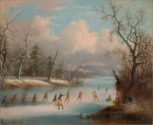Captain Cold, or Ut-ha-wah
Captain Cold, or Ut-ha-wah
On view in the American Art before 1900 galleries
Ut-ha-wah—Onondaga chief of the Six Nations, or Iroquois, a confederacy also known as the Haudenosaunee—distinguished himself while fighting on the American side during the War of 1812. A three-year encounter between Great Britain and the United States, the war was fought primarily to secure Canadian and maritime territory. John Wilgus shows the Native American chief in the classical stance of a military hero. However, Ut-ha-wah’s introspective gaze subverts the triumphant pose, imbuing the painting with a greater focus on the psychological state of the sitter. Ironically, portraits of American Indians became popular just as the subjects themselves “disappeared” following the Indian Removal Act of 1830, which mandated their departure from their ancestral lands.

